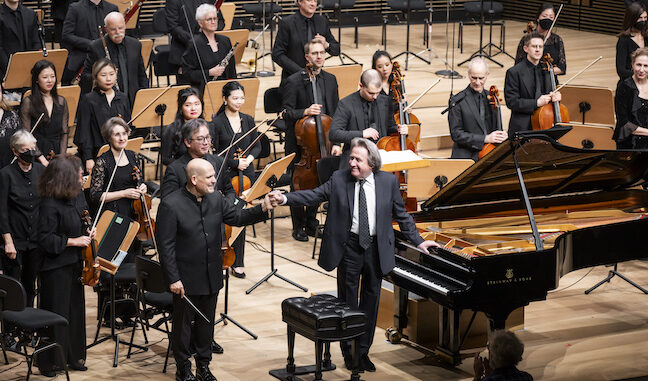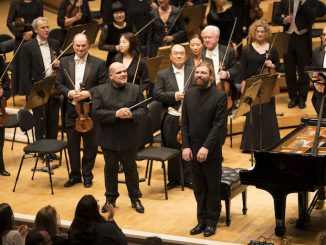
Three German War Horses, the Music Director’s last season, and a Legendary Keyboard Artist!
It was the Sunday, Jan. 7th, matinee where my concert companion and I were privileged to be seated midway in the now historically significant renovated Geffen Hall to attend the 4th and final performance of this series of concerts since last Thursday, of New York Philharmonic’s Music Director, JAAP van ZWEDEN, and the world-renowned Beethoven specialist, RUDOLF BUCHBINDER utterly captivate approximately 2,000 attendees eager to hear three top tiered masterpieces of 19th century German art, in three forms of exacting music.

The works, in order of performance, were Wagner’s Prelude to Act I of Die Meistersinger von Nurnberg (1862-67), Beethoven’s Piano Concerto #4 in G major, Op. 58 (1806), and Brahm’s Symphony #4 in E minor, Op. 98. (1884-85). One would be hard pressed to conjure three works of greater familiarity to regular classical concert goers in any corner of the avid listening globe over the past two hundred fifty years.
The challenge for first rate artists, such as these who were responsible, to provide anything new to experienced listeners with ANY of these pieces, let alone all three, while eschewing the vulgarity of attempting something, “new for newness’ sake”, would be, at best, daunting, or altogether impossible…..yet THAT was what this listener heard. This assessment was unmistakenly shared, not only by our fellow members of the audience, but as I discovered afterwards, by members of this ORCHESTRA, as well! “When it’s good, it’s GOOD”, as a charming lady seated behind us proclaimed, and who was I to contest so confident an utterance?
Bang! Bum Da- Dum! begins the Wagner Prelude to his sole “comic” opera that in its entirety still usually clocks at 4 and a half hours, yet manages to enchant audiences sans flying Valkyries, Dutchmen, or ancient magic love potions. No, it’s about ordinary yet talented humans in love and involved in a musical competition as to who can come up with the best song to hum along in this quaint 16th century town.

The prelude, when expertly played, is as exciting as any of the best of Broadway Golden Age overtures where “the chills” evoked for the listeners remain countless and stands as fabulous a showcase for a world class large ensemble as we’re blessed to have here. They created sounds that could well rival any performance at Wagner’s own acoustic designs at Bayreuth.
That is, particularly when it’s helmed by a first-class conductor and Music Director for whom this, at times, notoriously discriminating body of musicians has had five years of honing with him the exalted, rigorous, but never ponderous sounds of their collaborations. The tempi, energy, volume variance, sonority, accentuations in perfect detail, yet never sounding mannered or over thought, were gleefully rendered as though they were being played for the first time.
All this, despite it being the fourth time this week and who knows, other than the Phil’s archivist, how many hundreds of times this orchestra has sounded this particular celebration of musical creation since three years after its world premiere in 1868. Our city’s ensemble first played it under Carl Bergmann in 1871…..a fair amount of time to get it right and DID they! The brass section alone deserved unbridled plaudits yet were kept in perfect check via van Sweden’s baton and the aural awareness of ALL the musicians now able to hear as they’d never been allowed to before, since the recent renovations of this heretofore acoustically challenged hall. Among the few silver linings of COVID 19 was the forced closing in 2020 and the nearly two years devoted to finally getting this venue’s sound, sounding right after more than sixty years.

The second offering was perhaps the most sublime of the afternoon in providing one of the world’s foremost exponents of that native of Bonn whom many consider to be the most accessible great composer of western music. This concerto in G Major dates from what is now known as Beethoven’s “ middle period”. It was privately premiered in March of 1807 at the palace of one of his most devoted patrons, Prince Lobkowitz, and the following year in December, publicly at the Theater an der Wien in Vienna along with, among other masterpieces, both the 5th and 6th, symphonies, The Choral Fantasy, and the composer improvising at the keyboard as only he could.
It was indeed the last time, at age 38 when his fast-encroaching deafness prevented him from being able to play with an orchestra publicly again. Of his five piano concerti, it has often been the favorite of many legendary pianists. I recall Arthur Rubinstein unequivocally stating so in the liner notes of the first recording of this piece I acquired when I was still in High School. I’ve since added to that rendition those of Wilhelm Kempff, Leon Fleisher, Alfred Brendel, and even one of Artur Schnabel with the Chicago Symphony Orchestra and Frederick Stock from 1942.
I mention all this simply to inform you, dear reader, that with all the six decades of critical listening to this piece I’ve heard sounded, and superbly by each and all artists here named, I’ve never been more captivated and/or deeply moved than by what Rudolf Buchbinder, along with the support of van Sweden and the orchestra, in coming closer to what I believe the composer was reaching for with his Op. 58.

Among its distinctions is the fact that it’s the only one of the five where the piano is heard before the orchestra with five gentle measures in the key of G inviting the listener to attend that which indeed had never been heard before. Its deceptive simplicity opens a sonic door that requires a consummate musician, let alone, pianist, to be answered in hushed tones by the orchestra that sets the foundation of musical architecture that few souls have ever been endowed to painstakingly display.
Buchbinder, with the sublime accompaniment from van Sweden, cast just such a spell on the entire auditorium, and few moments passed before my companion felt compelled to provide me with tissue paper to wipe away my tears from the sheer, true, beauty of it all. The spell was never broken during the 35 minutes, when time became irrelevant, and Beethoven and his present acolytes gave us a glimpse of what treasures had been stored in his being, merely to be shared with all humanity, which was what it took for him to survive, despite his desperate plight of deafness.
Would that the composer could hear from above the ovation upon its completion by all the attendees standing, cheering full-throated, with gratitude beyond measure for this Sunday’s performance by these dedicated artists, 217 years since its premiere as though we were hearing it for the first time. There were numerous curtain calls, yet alas, no encore, from Maestro Buchbinder. He’d played with all his heart , and did so at each of the four performances this past week as I was authoritatively informed by no one less than the first chair of the Trumpet section, Christopher Martin, with whom we were able to chat post-concert. He was as affable in conversation as he’s first rate in his coveted chair.
Which brings me to the Brahm’s Fourth, which provided Mr. Martin, his section, all the brass, and indeed the entire 90 some players to continue the standards of excellence which had been so richly in evidence ever since the downbeat an hour earlier with the Wagner. I find it amusing now that these two contemporary composers Wagner and Brahms, who during their lifetimes and premieres, were the focal point of two separate camps virtually as divided as today’s political conflicts, in what promises to be an historic year for our nation.
Maestro van Sweden more than met the challenges of this heady work which was the culmination of this great Romantic Symphonist who thought that he’d never be able to follow in the “footsteps of the giant, Beethoven”, as his mentor, Robert Schumann had so confidently predicted in print some twenty years before the first such work of Brahms was dared before the public.
Once he marshaled his forces with the form, four masterpieces, all well received, and increased in popularity every year since, it became the yardstick by which symphonic works were to ensue. No work, for large ensemble of Brahms, contains greater intellectual substance of sheer abstraction, combined with a variety of tragic/ comic passions than his last and arguably most accomplished symphony first heard in Meiningen, Germany in 1885.

In the words of the great Conductor/ Pianist, Hans von Bulow, who was present at the premiere that the composer conducted, and shortly thereafter undertook the second performance himself in the same location: ” Difficult, very difficult. No. 4 gigantic, altogether a law unto itself, quite new, steely individuality. Exudes unparalleled energy from first note to last”.
It would be foolish for me to attempt a more vivid description. I can attest that the New York Philharmonic and its present Music Director fulfilled all that von Bulow assessed as Brahm’s 4th demands. How fortunate that we of The Big Apple retain such an ensemble, with so authoritative a leader as van Sweden, now playing in so superlative a hall!
May we partake of his stewardship, in this, his last season in his post, before he departs for South Korea and all the podiums that his musicality and humanity shall grace.
More about the New York Philharmonic


Be the first to comment